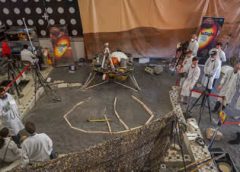By Mark S. Kuhar
NASA’s InSight lander set its first science instrument on Mars but engineers here on Earth already saw it happen. Like NASA’s Curiosity rover, InSight has a full-scale working model at the agency’s Jet Propulsion Laboratory in Pasadena, Calif. This sister lander, aptly named ForeSight, lets the team test all operations before they happen on Mars.
To practice how InSight placed its instruments, JPL engineers built a Martian rock garden modeled on images from the spacecraft’s cameras. The team raked, shoveled and patted down a bed of crushed garnet intended to simulate Martian sand. They call the shaping of this gravel-like material “Marsforming.”
A four-in. (10-centimeter) layer of garnet was added to the lab space in order to match the height and slope of the surface in front of InSight. Donning augmented-reality headsets allowed the team to project digital terrain models of the landing site onto the test bed, checking whether they needed to scoop more gravel into the space or smooth it out.
Wood blocks marked the perimeter of the areas where the lander’s seismometer and heat flow probe could be placed; precision cameras in the lab were used to measure each feature they intended to replicate. It took about four hours to mimic every detail, down to any pebbles or rocks larger than an inch (2 centimeters).
Larger rocks present various challenges, both to the lander and the instruments on the planet’s surface. The team had to make sure the electrical-wire-laden tethers that connect the instruments to the spacecraft won’t catch on or abrade against a sharp rock.
It’s great for the science we want to do,” said JPL’s Marleen Sundgaard, who guided the test-bed work. “It’s the flat parking lot the landing team promised us. You calculate the probability of rocks in the area and hope the odds are in your favor.”
The odds were very much in favor for InSight. “All around us, there are rocks that were ejected from nearby craters. These can be launched miles across the landscape, depending on the impact size,” said Nate Williams, a JPL post-doctoral researcher working with the mission. “Thankfully, there just aren’t a lot of rocks right in front of us.”
About 70 ft. (21 meters) from the lander lies a field of small boulders that would have made Marsforming harder, Williams said. He lent his geologist’s eye to the work, selecting rock samples for the test bed that matched the size, shape and locations of those near InSight.
The InSight mission is designed to solve mysteries about the interior of Mars, including its structure and how it formed, which could also shape scientists’ understanding of how Earth formed.
Source: NASA

